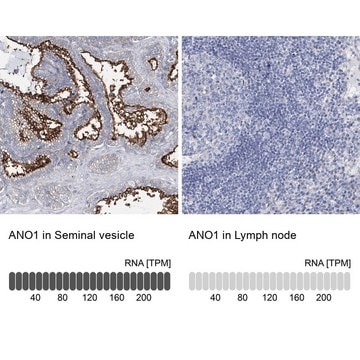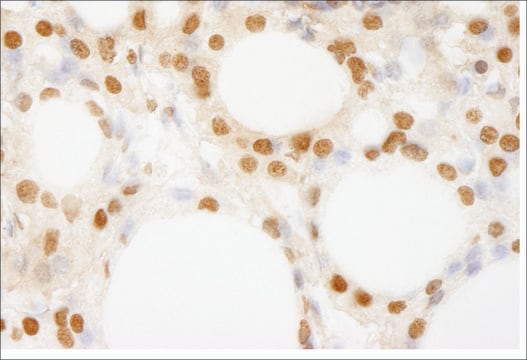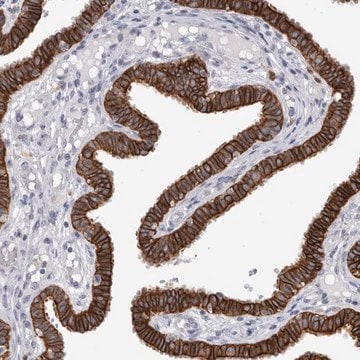ABN1669M
Anti-Anoctamin-1 (TMEM16A)
from rabbit
Synonyme(s) :
Anoctamin-1, TMEM16A
About This Item
Produits recommandés
Source biologique
rabbit
Niveau de qualité
Forme d'anticorps
affinity isolated antibody
Type de produit anticorps
primary antibodies
Clone
polyclonal
Espèces réactives
human, mouse
Réactivité de l'espèce (prédite par homologie)
rat (based on 100% sequence homology)
Conditionnement
antibody small pack of 25 μL
Technique(s)
immunocytochemistry: suitable
immunofluorescence: suitable
western blot: suitable
Isotype
IgG
Numéro d'accès NCBI
Numéro d'accès UniProt
Modification post-traductionnelle de la cible
unmodified
Informations sur le gène
human ... ANO1(55107)
mouse ... Ano1(101772)
Description générale
Spécificité
Immunogène
Application
Neuroscience
Immunofluorescence Analysis: A representative lot detected Anoctamin-1 (TMEM16A) in Immunofluorescence applications (Huang, F., et. al. (2009). Proc Natl Acad Sci USA. 106(50):21413-8; Wang, H.C., et. al. (2015). Cell. 163(6):1348-59; Huang, F., et. al. (2012). Proc Natl Acad Sci USA. 109(40):16354-9).
Immunocytochemistry Analysis: A representative lot detected Anoctamin-1 (TMEM16A) in Immunocytochemistry applications (Huang, F., et. al. (2009). Proc Natl Acad Sci USA. 106(50):21413-8).
Western Blotting Analysis: A representative lot detected Anoctamin-1 (TMEM16A) in Western Blotting applications (Huang, F., et. al. (2009). Proc Natl Acad Sci USA. 106(50):21413-8).
Qualité
Western Blotting Analysis: A 1:500 dilution of this antibody detected Anoctamin-1 (TMEM16A) in 10 µg of A431 cell lysate.
Description de la cible
Forme physique
Stockage et stabilité
Autres remarques
Clause de non-responsabilité
Not finding the right product?
Try our Outil de sélection de produits.
Code de la classe de stockage
12 - Non Combustible Liquids
Classe de danger pour l'eau (WGK)
WGK 1
Certificats d'analyse (COA)
Recherchez un Certificats d'analyse (COA) en saisissant le numéro de lot du produit. Les numéros de lot figurent sur l'étiquette du produit après les mots "Lot" ou "Batch".
Déjà en possession de ce produit ?
Retrouvez la documentation relative aux produits que vous avez récemment achetés dans la Bibliothèque de documents.
Notre équipe de scientifiques dispose d'une expérience dans tous les secteurs de la recherche, notamment en sciences de la vie, science des matériaux, synthèse chimique, chromatographie, analyse et dans de nombreux autres domaines..
Contacter notre Service technique






